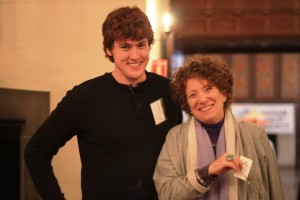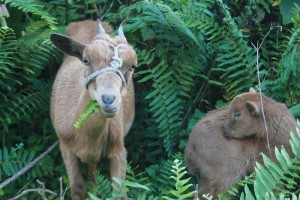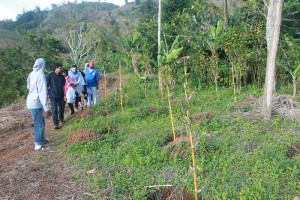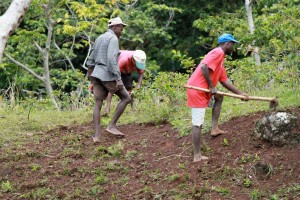November 15, 2013 by caplover
Below, Reforestation Initiative Director Tim Boycott ’16 describes his committee’s accomplishments this year, and explains what they hope to achieve moving forward.
“The semester has flown by for most people at Vassar. The leaves are already down in the Catskills, and almost there on the farm. Such a rapid passing of time has seen much action on the VHP front — especially with the Reforestation Committee. This academic year saw the formation of a brand new reforestation team, whose dedicated and enthusiastic students are carrying out the research for and the planning and execution of the initiative’s projects. We meet once a week to share updates about each of our various projects and set future goals.
Tim, Director of our Reforestation Initiative, with a guest at Art & Soul. 11.7.13.
One of the Reforestation Initiative’s well known projects is to plant 100,000 trees on a plot of land in Chermaitre. We launched this mission in 2008/2009, and so far we have purchased around 10,000 seedlings using funds raised from VHP art sales and donation cards. This year, we’ll continue with this reforestation plan using our recently secured Do-something grant to purchase equipment for planting and transporting seedlings. Recently, we’ve also submitted a grant proposal to American Forests that, if secured, will go towards buying and planting our next set of seedlings.
Wildlife in the Chermaitre mountains.
The figure of 10,000 seedlings planted appears impressive, but we know from more recent trips to Chermaitre that only a fraction of those seedlings have survived. Many perish on the long journey from nurseries to Chermaitre, and many more are lost once planted, as the soil conditions in the village are less than optimal. As a result of this realisation, we began researching reforestation practises used in areas of poor environmental health that have improved tree survival rates. Our searching soon led us to the field of agroforestry.
Students on our 2013 March Trip.
Agroforestry suggests planting trees and shrubs on plots of land that already support crops and livestock. It thus combines agricultural and forestry techniques to create a more diverse, healthy, and generally ecologically sound system. This sustainable method ultimately increases productivity. VHP had not employed agroforestry techniques in its reforestation efforts, even though Chermaitre enjoys a level of agriculture. We were initially far from experts in the field agroforestry, and sought a collaboration with a knowledgable organisation that practises these techniques.
A look at the land.
Our search for information soon led us to Smallholder Farmer’s Alliance, a Haitian organisation that uses agroforestry techniques for their small-scale community based projects. VHP met with the organisation’s heads, Timote George and Hugh Locke, at one of their NYC events. One thing led to another and, on our trip to Haiti in October, VHP representatives met with Timote George once more to discuss routes forward. Now, a VHP representative from Chermaitre is due to meet with Timote to get a tour of the organisation and its projects. We think our relationship with Smallholder Farmer’s Alliance will prove a valuable one, and that it will contribute to the introduction of sustainable agroforestry techniques in Chermaitre. The successful reforestation of the land, as well as the associated benefits of increased agricultural productivity, will be highly beneficial to the people of Chermaitre.”
— Tim





